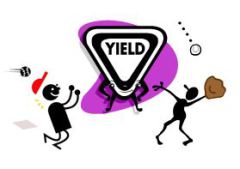Obstruction and Interference
What is Obstruction and Interference?
Obstruction and interference are rule violations that occur in the field of play, typically involving base runners.
Comparison between obstruction and interference
Fielder or runner: who has the "right of way?"
Obstruction and interference can be confusing when deciding and explaining a call. Remember – defense obstructs, offense interferes.
|
Obstruction |
Interference |
|
When a fielder, without possession of the ball, impedes the progress of a runner
Always done by the defense (fielders) |
(Most often) when a runner interferes with a fielder attempting to make a play Almost always done by the offense (team at bat) |
|
Typical examples:
- Fielder standing in front of a bag (or in the base path) awaiting a thrown ball - Fielder standing in the base path not paying attention - Fielder standing in the base path of a runner attempting to steal a base after a pitch - A run down (aka “pickle”) where a fielder is in the base path waiting on a thrown ball |
Typical examples:
- Runner collides with a fielder making a play on a batted ball - Runner is hit by a batted ball - Runner obscures the fielder’s vision while attempting to field a batted ground ball
|
|
When it occurs, play stops (umpire calls time) depending on the type of obstruction (below)
Generally, the runner is awarded base(s)
Other runners typically advance to the base they were approaching at the time of the obstruction |
When it occurs, play always stops (umpire calls time) at the time of the interference
The runner is called out
All other runners typically return to the last base touched prior to the interference |
There are two types of obstruction that determine if and when the umpire stops play
- Type A: play is being made on the obstructed runner. Play stops immediately (umpire calls time) and a dead ball results.
- Type B: play is not being made on the obstructed runner. Play continues and the umpire may call time later depending on the play outcome.
- Learn more about type A and B obstruction.
Knowing who has the "right of way" will help you decide between an obstruction or interference call
1. On a batted ball: the fielder has the right to the ball including within the base path.
- If a runner impacted a fielder's attempt to make a play on the ball, the ruling is interference on the runner.
- Only one fielder is protected against interference (umpire judgement).
- If a fielder makes an error on the play, he is still protected by the interference rule if he attempts to get a loose ball that is within a “step and a reach”.
2. On a thrown ball: the runner has the right to the base including along the base path.
- If a runner's path to a base was altered, for example if he slowed down or ran around a fielder (without possession of the ball), the ruling is obstruction on the fielder.
3. If a fielder has possession of the ball - he can stand wherever he wants without risk of being called for obstruction.


